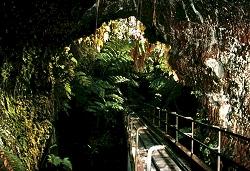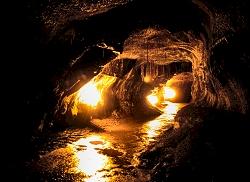Thurston Lava Tube
Nāhuku
Useful Information

| Location: | Hawaii Volcanoes National Park, Island of Hawai'i (Big Island), 160 km from Kailua-Kona and 48 km from Hilo. |
| Open: |
Thurston Lava Tube: closed. Park: 24 hours a day all year. Kilauea Visitor Center: daily 9-17. [2020] |
| Fee: |
Thurston Lava Tube: free. Entrance to the park (7 day permit): Private Vehicle USD 30, Motorcycle USD 25, Bicycle USD 15, Pedestrian US 15. Groups: Per Person USD 15. [2020] |
| Classification: |
 lava tube lava tube
|
| Dimension: | |
| Guided tours: | |
| Photography: | allowed |
| Accessibility: | no |
| Bibliography: | |
| Address: |
Hawaii Volcanoes National Park, P.O. Box 52, Hawaii National Park, HI 96718-0052 Park Headquarters/Visitor Information Tel: +1-808-985-6000 (daily 7:30-16), Fax: +1-808-967-8186 (24 hours) Eruption Information Message (24 hours) +1-808-985-6000 |
| As far as we know this information was accurate when it was published (see years in brackets), but may have changed since then. Please check rates and details directly with the companies in question if you need more recent info. |
|
History
| 1913 | discovered by Lorrin A. Thurston, a local newspaper publisher and conservationist. |
| 1987 | included into UNESCO world heritage list. |
| FEB-2018 | LED light system installed. |
| Summer 2018 | eruption with earthquakes damages the cave, cave is closed. |
Description


Thurston Lava Tube or Nāhuku is located in Volcano National Park on Big Island, Hawai'i. It was for a very long time the only show cave amongst the numerous lava tubes on the Hawai'ian islands. It is one of numerous sights of the Park, and like the other sights it can be visited all day without restrictions on a self guided tour.
The park also has several active volcanoes. An eruption which continued for decades reached a state, where the lava flow built its own tunnel, which is still filled with lava. The lava flows underground and reappears after several kilometers at the sea.
Thurston Lava Tube was created by an much earlier lava flow which originated higher up Mauna Loa. The eruption ended, the lava left the tube and it cooled down. Today its rather cool and moist inside, as the area above the cave is covered by rain forest. The roots of trees and other plants go through the roof of the cave and hang down from the ceiling.
Thurston Lava Tube is entered through a collapsed part of the roof. The cave is obviously a single passage, nearly round and of nearly constant diameter. It winds uphill with about 2%. The exit is another, much smaller, collapsed part of the roof. Thurston Lava Tube is pretty short, 150 m is not much compared to other lava tubes with tens or hundreds of kilometers. On the other hand, lava tubes are very uniform, so you can see most typical features of this type of caves in Thurston Lava Tube very well.
In 2017/2018 the old and rather annoying electric light of the cave was replaced by a modern LED light system It operates automatically, it is on between 10 and 20 daily. So visitors who want to see the unlit cave have to come early or late. Despite the light it is recommended to bring a torch.
Unfortunately, right after the new light system was installed, the eruption of summer 2018 changed anything. The eruption was connected with earthquakes and during those earthquakes Thurston was damaged. It was closed indefinitely - some say it might never reopen. The NPS says on their website: "We will reopen Nāhuku again, but do not have a timeline" [2020]. Fortunately Thurston Lava Tube is not the only lava tube open to the public any more. You could visit Kaumana Cave or Kazumura Cave instead. The eruption also caused a 134 day long total closure of the park, the crater rim road was partly destroyed, Jaggar Museum and the USGS Hawaiian Volcano Observatory were damaged and are unsafe.
- See also
 Subterranean World Heritage List
Subterranean World Heritage List Search Google for "Thurston Lava Tube"
Search Google for "Thurston Lava Tube" Google Earth Placemark
Google Earth Placemark An Enlightening New Experience in Thurston Lava Tube (visited: 10-MAY-2020)
An Enlightening New Experience in Thurston Lava Tube (visited: 10-MAY-2020) Hawaii Volcanoes National Park (visited: 17-APR-2021)
Hawaii Volcanoes National Park (visited: 17-APR-2021) Unterirdisch (
Unterirdisch ( )
) Hawaii: With Thurston Still Closed, What Lava Tubes Can You Visit on the Big Island? (visited: 10-MAY-2020)
Hawaii: With Thurston Still Closed, What Lava Tubes Can You Visit on the Big Island? (visited: 10-MAY-2020)
 Index
Index Topics
Topics Hierarchical
Hierarchical Countries
Countries Maps
Maps Search
Search